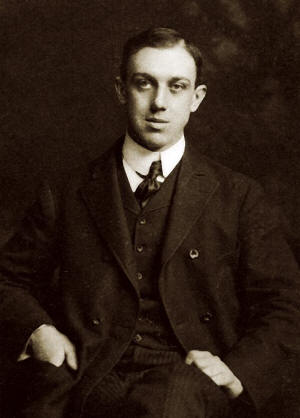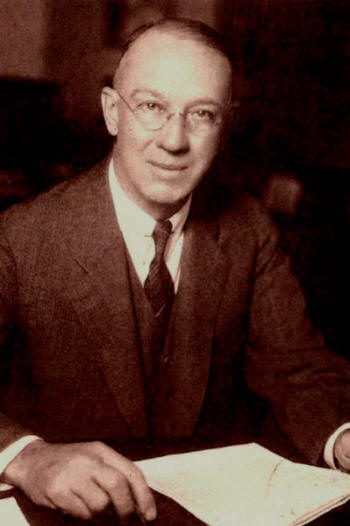Frank Newman Speller
(January 1st, 1875 and died January 1st, 1968)
The United States can rightfully boast of its many pioneers in science and engineering who have contributed greatly to progress. Standing high among these leaders in science, although he does not like to be credited as such, is Frank Newman Speller, one of the foremost pioneers in corrosion control engineering who is recognized internationally for his leadership in corrosion work, said Dr. Mars G. Fontana, when he was chairman of Ohio State University's Department of Metallurgical Engineering and editor of NACE's journal Corrosion. (reference)
Speller was very modest about his long career as a metallurgical engineer with the National Tube Company (later a division of U.S. Steel Corporation), about the many honors he has received for his work in corrosion and metallurgy, and about his book, Corrosion-Causes and Prevention, which became the textbook on corrosion in many universities and colleges.
Dr. Speller preferred to talk about his recreational activities such as ice skating, boating, and world travels-all these actively participated in by a 90 years old man. He was also reluctant to discuss the many medals, citations, and certificates that hang in his second floor office at his Pittsburgh home. These honors included an honorary Doctor of Science degree from his alma mater, the University of Toronto (1923), the Longstreth Medal (1927) from the Franklin Institute for his method of producing welded pipe with thin scale that is hard and smooth, the American Iron and Steel Institute medal (1931), and the Max Hecht Award from the American Society for Testing and Materials (ASTM) (1960).
However, the award that Dr. Speller said he valued most was the one presented to him by the National Association of Corrosion Engineers, an award named in his honor in recognition of his leadership in corrosion engineering. Since 1947, when Dr. Speller received the first award, 17 other distinguished corrosion engineers have been given the Frank Newman Speller Award, for recognition of their public contributions to corrosion engineering. Although he has been retired since 1940, he continually read technical journals on corrosion, and keeps abreast of new developments. He has been a consultant since his retirement.
When he did his first work in corrosion shortly after the turn of the century as a chemist wile National Tube, Speller was one of just three or four men in this country who were showing A interest at all in corrosion - then considered most of industry as just a nasty phenomenon that had to be contended with.
 Right Place, Right Time
Right Place, Right Time
How did he get into corrosion work? Dr. Speller insists that he was lucky:
he was at the right place at the right time.
The right place was National
Tube Company in McKeesport, Pennsylvania. The right time was about 1902 when
the company had to decide what the material of the future would be for its pipe
and tubing - the newer steel or the older wrought iron. The company was a pioneer
manufacturer of steel pipe but also made wrought iron pipe because it was demanded
by customers. National Tube wanted to know whether it should continue making
pipe of both materials or drop one. The company wanted to know if there was
anything in the popular opinion that wrought Iron was more durable.
The right place was National Tube Company in McKeesport, Pennsylvania. The right time was about 1902 when the company had to decide what the material of the future would be for its pipe and tubing - the newer steel or the older wrought iron. The company was a pioneer manufacturer of steel pipe but also made wrought iron pipe because it was demanded by customers. National Tube wanted to know whether it should continue making pipe of both materials or drop one. The company wanted to know if there was anything in the popular opinion that wrought Iron was more durable.
George Crawford, National Tube's manager, asked the young Speller to investigate the merits of the two materials and to make a report within a year or two. "That job was the turning point for me," Speller admits.
Lacking time for a lengthy investigation, Speller had to resort to short exposure tests and to rely heavily on case history data collected throughout the United States. About 100 cases were found where both steel and wrought iron were used together as tubing. After this investigation, done in addition to his regular work, Speller reported that, as far as corrodibility was concerned, there was no valid basis for the company's making wrought iron pipe.
Customers Blamed Manufacturers
Back at the turn of the century, users of metallic tubing blamed the manufacturer for corrosion; they thought the pipe corroded because it was made of rotten material and that as a rule there was no other explanation.
Because of his initial work on the problem of corrosion, Speller was given the assignment of persuading customers of the merits of steel pipe and of convincing them that corrosion on the pipe was caused by the environment. This required research, considerable data, and a field organization to cooperate with the sales force of the company.
In 1906, with his new assignment, he was appointed as head of the metallurgy department. One of the most important discoveries made by Speller in his pioneering work was that no simple, economical means could be used by the manufacturer to eliminate the corrosion problem.
Other Preventive Measures
Other than providing pipe of sound quality and uniform finish, there was apparently nothing more that could be done economically by the manufacturer to improve the durability of carbon steel pipe unless more expensive materials were used. Therefore, Dr. Speller's attention was focused on other corrosion preventive measures: coatings, water de-activation, and inhibitors that could be applied by the user.
National Tube discovered that a technical services department was necessary to explain to the customers that corrosion usually was caused by the environment and not necessarily by poor materials. "That's why we now have the consumer's interest so largely represented on the NACE Technical Committees," Speller maintains. "Take the oil and gas companies. They realize that the solution of the corrosion problem is largely in their hands. Manufacturers, of course, are responsible for working to certain specifications, but they are not responsible for where the material is used and how it is used."
Other Work Related to Corrosion
Speller was asked to be the chairman of the metallurgical advisory board for a study begun in 1923 on the chemistry of steel making. He served as chairman for seven years ' and also was chairman of the executive committee of the study.
This study was organized by Carnegie Tech with support and assistance from the Bureau of Mines and the steel industry. It had a bearing on corrosion because irregularities in steel affect the material's corrosion rate, but the study's primary purpose ' was to improve the quality of steel.
The study ended with the publication of a book titled "The Physical Chemistry of Steel Making" by C. H. Herty, Jr. Dr. Speller believes the most significant result of the study was that each of the steel companies realized the importance of research and established their own research centers.
 Book Published in 1926
Book Published in 1926
As his work in corrosion continue, his files became loaded with experimental and case history data dealing with corrosion of steel pipe. Dr. W. Walker, a close friend at MIT, suggested that all these data could be quite useful if collected and logically arranged in a book. This became another challenge to Dr. Speller which resulted in the publications of his book in 1926, after several years work beyond his normal responsibilities and with the financial help of U.S. Steel. The book was well received and became a standard textbook in corrosion engineering.
A second edition was printed in 1935 and a third in 1951 to include all the advances in corrosion technology that had come about since his work back in the early 1900's.
Busy Retirement Begun
His retirement had hardly begun in 1940 when the Panama Canal authorities asked Speller for a consultation as to what corrosion prevention should be used to permanently protect the emergency gates on the canal locks.
The U.S. government was concerned about the emergency gates on the canal which are submerged in a concrete slot below the locks and are constantly immersed in brackish water. These gates were designed to be pulled up in case the lock gates were damaged or failed to close, permitting the water to be drained to sea level, knocking the canal out of action.
Speller recommended that a full time corrosion engineer be employed to be certain that adequate cathodic protection was maintained on those important gates.
Papers pertaining to this Panama Canal job were stolen from Speller's Pittsburgh home. Although it was established later that the thieves were enemy agents, the stolen papers were of no advantage to their cause.
Speller's Advice to the Young
"My old dean of engineering at the University of Toronto used to tell his graduates that, as a rule, they are not worth more than their living expenses to a company for the first five or six years after graduating until they have acquired more practical experience."
This point is illustrated by an incident he recalls from his work in the Homestead Steel Works about four years after graduating from college. He stopped the general superintendent (Charles Schwab) in the mill yard one day and asked what he might do for advancement. This well known manager smiled at Speller and replied, "See those three men placing a cable around those steel beams. Find a way to get it done with two men and you'll get on." Speller admits that Schwab's remark encouraged him to develop his own initiative and to work hard. He believes that advancement depends on what a person does outside

Connect with us
Contact us today